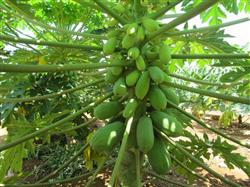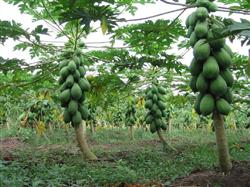Control of root rot of papaya seedlings

Papaya is a subtropical crop, which is raised and transplanted. The analysis shows that the main causes of root rot at seedling stage are stagnant water in seedling bed after rain, high concentration of fertilization at seedling stage, invasion of nematodes and root rot pathogens. Prevention and control measures: 1. The root system of papaya should breathe in the soil. during anoxic respiration under anoxic conditions, the biochemical reaction inside the roots produces methanol (alcohol). Due to alcoholism, rotting roots occur, this phenomenon is mostly caused by stagnant water in the seedling bed or soil consolidation resulting in lack of oxygen in the soil. the drainage ditch between the bed and the bed should be opened to prevent the seedling bed from flooding after rain. 2. The root system of papaya seedlings is young, and it is better to apply fertilizer at a dilute concentration. The concentration is too easy to cause the young roots not to be absorbed. On the contrary, the free water in the young root cells permeates and dies, causing rotting roots. That is, as farmers often say, "crops are burned to death by fertilizer." 3. After the roots of papaya seedlings were damaged by nematodes, the internal tissue of young roots was destroyed, which hindered the absorption and transport of nutrients to the plants. when found, 70% chlorothalonil 600 times solution or 70% chlorothalonil 800 times solution could be sprayed. 4. The occurrence of root rot is a disease that causes root rot of seedlings. When it occurs, the mu is sprayed with 25% trimethoprim, 5 ml, 6 g and 500 mol ·m-1 water.
- Prev

Cultivation and management techniques of papaya
1. Select excellent varieties. Suitable for local varieties are Yizhou papaya, poinsettia papaya and so on, and can pollinate each other. 2. Planting and establishing the garden. It is appropriate to choose loam or sandy loam with deep and fertile soil layer, good drainage, neutral or slightly alkaline soil. The row spacing is 2.5 m × 4 m. Dig 1 m long, 1 m wide and 0.8 m deep before planting.
- Next

Economic fertilizer application amount and suitable proportion of papaya trees
The amount of economic fertilizer application is the lowest amount of fertilizer application when high yield, high quality (or high economic benefit) is obtained due to the effect of fertilization. Practice has proved that, in a certain range, the yield and quality often improve with the increase of fertilizer application. However, when the amount of fertilizer application reaches a certain level, the yield and quality of fruit will increase with the amount of fertilizer application.
Related
- Moge, come on! The staff of the peasant association in the producing area of cantaloupe were frightened when the crowd gathered.
- Causes and Solutions of low Fruit setting rate of Apple
- Symptoms and control measures of passion fruit virus disease
- Fruit growing lesson: how do apple orchards keep high yields?
- Can you build orchards in the mountains? What are the pros and cons?
- How to manage the coloring period of Crisson grape?
- This paper introduces the processing technology of two kinds of fig products.
- How much is a month for retired teachers in rural areas by 2020?
- How can strawberry planting increase sugar content? We should pay attention to management in many aspects.
- What are the cultivation techniques on how to improve the yield of golden fruit?

